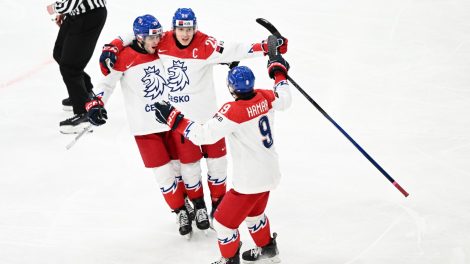VANCOUVER — I’ll take smaller ice for 200 — by 85 — Alex.
At a time when rising concussion awareness has some North American hockey people discussing whether the National Hockey League should move to a bigger, Olympic-sized ice surface, the head of the International Ice Hockey Federation dropped a bombshell Saturday morning in Vancouver.
At his press conference on the final day of the 2019 World Junior Championship, IIHF president Rene Fasel said he prefers the smaller, North American ice. He promised to push international hockey to adopt the 200-by-85 foot surface — starting with two major hockey events in 2022.
“In Beijing 2022, if (the NHL) is there, we will ask the organizers to play on the small ice. And in Finland in 2022 we will play on small ice at our world championship,” said Fasel. “The future is having the best players of the world playing on the small ice. Why should we not be playing on the small ice?”
Currently, IIHF events played outside North America are played on sheets of ice that measure 200 by 100 feet. European leagues are almost exclusively played on the bigger surface, and the extra space has made for a more defensive game with far less body contact.
There are many in North America who would like to see less contact — or more pointedly, less injuries — who have advocated for making NHL rinks larger. Those who prefer more goals, more speed, more hitting and more excitement however, have been almost unanimous in their belief that the smaller NHL surface makes for a better game.
[relatedlinks]
We once asked Finn Teemu Selanne, who grew up playing on the larger surface back home, what the biggest difference was. He gave the example of being on the half-wall just above the hashmarks, and attacking the opponents net.
(We paraphrase here, because it was an unrecorded conversation from several years ago.)
“When I beat the defenceman coming off the wall in the NHL, I take one, maybe two strides and I am at the goal in prime shooting position,” Selanne said. “In Europe, if I beat the defenceman I still need three or four strides to get to the same position. But by then, the other defenceman has come over to cut me off. So now, I have to beat two plays to get the same shot.”
Another issue with European hockey is a team’s unwillingness to forecheck. With more room, defencemen have more time to move the puck successfully before being hit by the oncoming forechecker, who has much further to go on the big surface to execute the hit. Now, having missed on the hit, our forechecker is so far out of position that he has left his team short defensively.
Over time in Europe, that player — or more likely his coach — has decided that it’s just not worth forechecking aggressively at all. Instead, the player falls back to a neutral-zone position, clogging up the ice and making it even harder for teams to create offence.
“It is a different game, especially for the juniors, and the women’s game also,” Fasel said of the smaller ice. “It (produces) another game. For the hockey fan — a different game than we played … even five years ago. The young players here, (Patrik) Laine and (Connor) McDavid, and all of these 19- and 20-year-olds (at the WJC) … can you imagine that these guys would ever be able to play the game at this (speed)? I don’t think so.”
It is simple physics: The bigger ice makes for longer travel times to get to the dangerous scoring areas. Thus, less scoring.
The bigger ice also makes the game appear slower. As such, the lesser speed of the women’s game, though it continues to make gains, is exacerbated on the Olympic surface. So is para ice hockey, formerly known as sledge hockey, better served by the smaller surface.
Fasel believes that new rinks overseas should be built to NHL specs, and that even some older ones can be changed.
“We should be flexible,” he said. “It is possible to do it. To extend is more difficult than to make it smaller.”
As for those who want a bigger surface in the name of less collisions?
Well, Saturday was a day when that dream took a serious hit.









